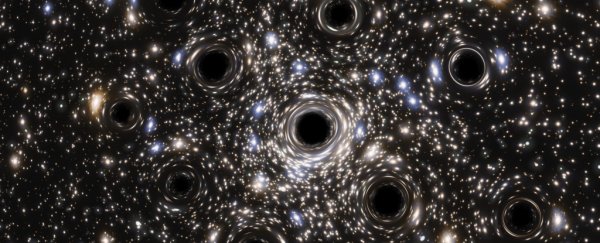For decades, astronomers have theorized that black holes fall into three broad categories.
There are the stellar-mass black holes, which range from five to 50 times the mass of our Sun. Then, there are supermassive black holes (SMBHs), which are millions to billions of times more massive than the Sun.
Finally, there are intermediate black holes (IMBHs), with masses that fall somewhere in between.
Whereas scientists have observed plenty of stellar mass black holes and SMBHs, evidence of IMBHs has been a lot harder to come by. That has posed a problem: IMBHs are thought to be the transitional bridge between stellar black holes and SMBHs as they grow, a glaring 'missing link' in black hole evolution.
In a series of new studies, an international team led by researchers from Vanderbilt University's Lunar Labs Initiative (LLI) has announced that it may have found evidence of these elusive objects.
In one of the papers, a team led by astronomers Krystal Ruiz-Rocha and Anjali Yolkier describes how the researchers reanalyzed data from the Laser Interferometer Gravitational-Wave Observatory (LIGO) and the Virgo Collaboration to search for possible indications of IMBH mergers.
The results indicate that these observatories recorded gravitational wave events that correspond to mergers between black holes that were 100 to 300 solar masses. This makes these events the largest black hole collisions recorded by astronomers, and places them in the range where they expect lightweight IMBHs to be.
"Black holes are the ultimate cosmic fossils," says astronomer and senior author Karan Jani.
"The masses of black holes reported in this new analysis have remained highly speculative in astronomy. This new population of black holes opens an unprecedented window into the very first stars that lit up our Universe."
In related research, scientists showed how the upcoming Laser Interferometer Space Antenna (LISA) mission, which is scheduled to launch in the late 2030s, could help verify these results.

Whereas detectors like LIGO and Virgo can capture the final stages of a black hole collision, LISA will be able to track them for years before they merge as they spiral in towards each other, generating ripples in space-time. This extended observational timeframe will allow astronomers to learn more about the black holes' origin, evolution, and what will become of them.
"We hope this research strengthens the case for intermediate-mass black holes as the most exciting source across the network of gravitational-wave detectors from Earth to space," says Ruiz-Rocha.
"Each new detection brings us closer to understanding the origin of these black holes and why they fall into this mysterious mass range."
Looking ahead, the team plans to explore how IMBH could be observed using gravitational wave observatories on the Moon.
NASA is exploring the possibility of building just such an observatory on the Moon as part of the Artemis program's long-term objectives. This plan has existed since the Apollo Era and would build on the Lunar Surface Gravimeter experiment left behind by the Apollo 17 astronauts.
"This is an exciting moment in history – not just to study black holes, but to bring scientific frontiers together with the new era of space and lunar exploration," says Jani.
"We have a rare opportunity to train the next generation of students whose discoveries will be shaped by, and made from, the Moon."
The findings are reported in The Astrophysical Journal Letters, with supporting research published in The Astrophysical Journal, here, here, and here.
